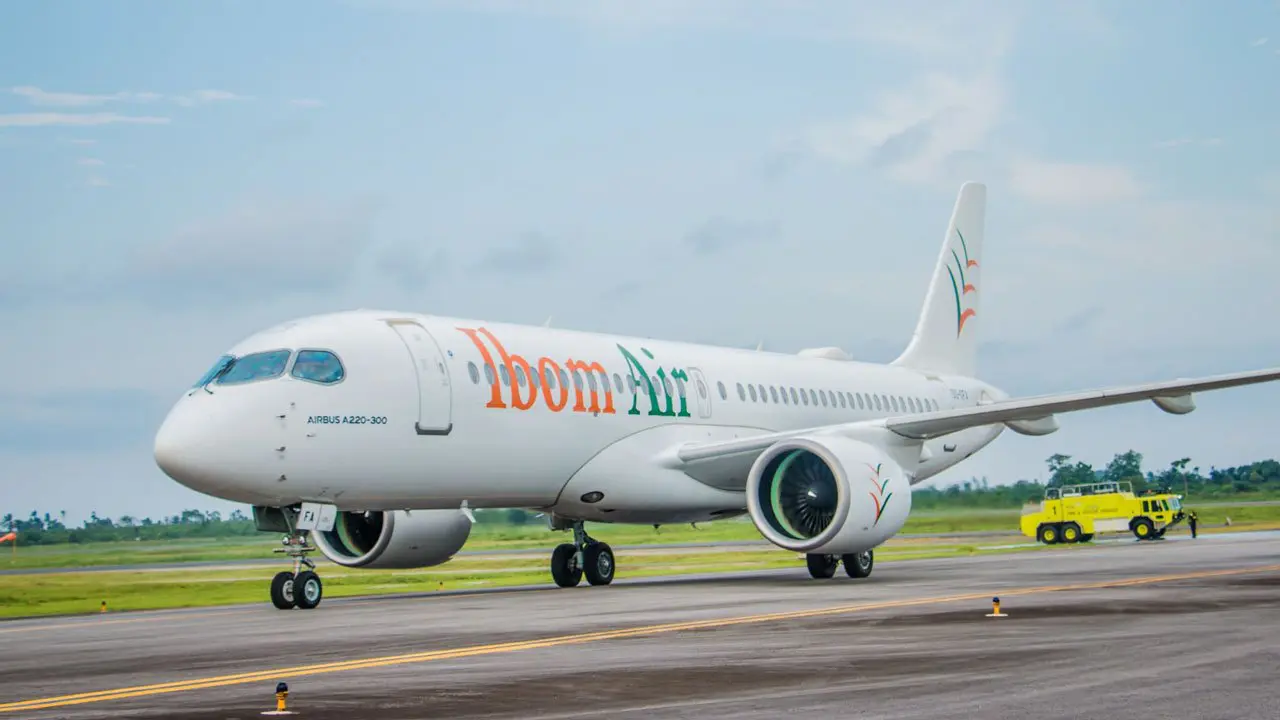Ibom Air: Airplane Mode Or Power Off—What’s The Real Standard?

On August 10, 2025, an Ibom Air flight from Uyo to Lagos spiraled into chaos when passenger Comfort Emmanson, after switching her phone to airplane mode, was asked to power it off completely before takeoff.
Her refusal escalated into a violent confrontation, involving alleged assault on crew members, attempt to wield a fire extinguisher, and clash with airport security, leading to her arrest and a lifetime ban from Ibom Air and other Nigerian airlines, according to a statement released by Ibom Air.
The incident reported by THE WHISTLER, has many asking: what is the standard practice during flights—enabling airplane mode or switching off phones entirely?
Let us examine the protocols, expert insights, and the implications.
The Standard Practice
Airplane mode, a feature on nearly all modern smartphones, tablets, and laptops, disables wireless signals—cellular, Wi-Fi, and Bluetooth—to prevent potential electromagnetic interference (EMI) with an aircraft’s communication and navigation systems.
The Federal Aviation Administration (FAA), European Union Aviation Safety Agency (EASA), and International Air Transport Association (IATA) universally endorse airplane mode as the standard practice for personal electronic devices (PEDs) during flights, particularly during critical phases like takeoff and landing.
The FAA’s regulation (14 CFR § 91.21) allows PEDs to be used in airplane mode if airlines verify no interference, while EASA’s AMC1 CAT.GEN.MPA.140 permits similar use after safety assessments. The Nigerian Civil Aviation Authority (NCAA) aligns with these global standards, requiring devices to be in airplane mode or off during critical phases, as per NCAA Advisory Circulars (2022).
Switching off a phone entirely eliminates all potential EMI, as it stops all device operations, including passive signal emissions.
In the 1990s and early 2000s, when avionics were less shielded and mobile phone technology was less understood, complete power-off was often mandated. However, advancements in aircraft design and testing have shifted the standard to airplane mode.
A 2013 FAA study found no strong interference from devices in airplane mode, leading to relaxed rules allowing gate-to-gate use in this setting. IATA’s 2013 report noted only 29 suspected EMI cases from 2003–2009, none conclusively linked to phones.
Despite this, some airlines, like Ibom Air in the Emmanson case, may request devices be powered off entirely, particularly during takeoff and landing.
When contacted by THE WHISTLER on LinkedIn, Aviation safety expert Michael Daniel explains, “Modern aircraft have wiring that reduces the high-intensity radiated field (HIRF) effect, but a powered-off device guarantees zero risk. We don’t take chances with safety.”
Why Airplane Mode Is The Global Standard
Airplane mode disables cellular signals, which could create a “buzzing” noise in pilots’ headsets, as noted by pilot PerchPoint in a December 2024 TikTok video. Airplane mode mitigates this effectively without requiring a full shutdown.
Unlike powering off, airplane mode allows passengers to use devices for offline tasks like reading, gaming, or watching downloaded content. This balances safety with passenger convenience.
Phones not in airplane mode continuously search for signals at cruising altitude, draining batteries and straining ground networks.
When Is Switching Off Required?
Though airplane mode is the global standard, some airlines or crews may request devices be powered off during critical phases or specific situations, as seen in the Ibom Air case. This can occur due to some carriers, particularly in regions with older aircraft fleets or stricter local regulations, mandating powering off to eliminate any theoretical risk.
During takeoff and landing, pilots rely heavily on clear radio communications. A 2024 RTCA study noted that active cellular signals could interfere with older navigation systems, prompting some airlines to enforce power-off rules for added safety. Flight attendants may request devices be turned off if passengers appear non-compliant or if they suspect a device isn’t properly in airplane mode.
The rollout of 5G has raised new concerns about interference with radio altimeters, particularly in the U.S., where 5G frequencies (3.7–3.98 GHz) are close to altimeter bands (4.2–4.4 GHz). The FAA has flagged this risk, leading some airlines to enforce stricter rules, including powering off devices.
Consequences Of Non-Compliance
Beyond legal or operational consequences, non-compliance risks minor EMI, such as headset buzzing, which could distract pilots during critical phases.
Pilot Randle Corfman notes, “Even a small buzzing sound can interfere with hearing ATC instructions clearly.”
Is Airplane Mode Sufficient, Or Is Powering Off Necessary?
Experts overwhelmingly support airplane mode as sufficient for safety.
EasyJet pilot Chris Foster argues in a 2024 interview with Liverpool Echo, that airplane mode rules are “outdated” given modern shielding, and Europe’s 2023 adoption of 5G picocells allows in-flight cellular use on equipped aircraft.
“It really wouldn’t be a problem. Aircraft control systems are so sophisticated now, that they wouldn’t cause any interference.
“The regulations date back many years to when we didn’t even have things like iPads. The laws are starting to be relaxed – you can now use your devices in flight safety mode – and I think we’ll see more changes over the next few years,” he stated.
Yet, in regions like Nigeria or the U.S., where 5G interference concerns persist or older aircraft are in use, powering off may be requested as a fail-safe, as seen in Emmanson’s case.
Icelandair’s Gudmunder Tomas Sigurdsson and Vice President of Flight Operations states, “A single phone may not cause a major issue, but multiple active devices transmitting signals increase risk.”
Airplane mode eliminates these signals, making it the practical standard. However, the Ibom Air case explains why some airlines insist on powering off: it ensures zero risk, eliminates ambiguity, and reinforces crew authority during high-stakes moments.
Ibom Air: Airplane Mode Or Power Off—What’s The Real Standard? is first published on The Whistler Newspaper





